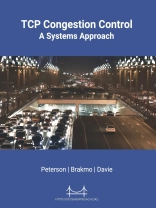TCP Congestion Control has been a research topic for over 30 years. Since the pioneering work of Jacobson and Karels in the 1980s, hundreds of researchers have sought to improve the avoidance and control of congestion in the Internet. Over time, new ideas such as using delay as well as packet loss to detect congestion have taken hold. This book walks through all the key approaches and gives the reader a framework to understand the big picture and ongoing challenges of congestion control.
Features:
- Emphasizes underlying concepts, key principles and design choices.
- Covers developments in congestion control from its early days through to the latest innovations.
- Includes both host-based approaches and router-based techniques such as Random Early Detection.
- Describes methodologies used to evaluate new congestion control algorithms.
Cuprins
Foreword
Preface
Chapter 1: Introduction
1.1 What is Congestion?
1.2 Controlling Congestion
1.3 Theoretical Underpinnings
1.4 Congestion Control Today
1.5 Reference Implementation
Chapter 2: Background
2.1 Best-Effort Packet Delivery
2.2 Reliable Byte-Stream
2.3 High-Speed Networks
Chapter 3: Design Space
3.1 Implementation Choices
3.2 Evaluation Criteria
3.3 Comparative Analysis
3.4 Experimental Methodology
Chapter 4: Control-Based Algorithms
4.1 Timeout Calculation
4.2 Additive Increase/Multiplicative Decrease
4.3 Slow Start
4.4 Fast Retransmit and Fast Recovery
4.5 Incremental Enhancements
4.6 TCP CUBIC
Chapter 5: Avoidance-Based Algorithms
5.1 TCP Vegas
5.2 Varied Assumptions
5.3 TCP BBR
Chapter 6: Active Queue Management
6.1 DECbit
6.2 Random Early Detection
6.3 Controlled Delay
6.4 Explicit Congestion Notification
6.5 Ingress/Egress Queues
Chapter 7: Beyond TCP
7.1 Datacenters (DCTCP, On-Ramp)
7.2 Background Transport (LEDBAT)
7.3 HTTP Performance (QUIC)
7.4 TCP-Friendly Protocols (TFRC)
7.5 Multipath Transport
7.6 Mobile Cellular Networks
Despre autor
Bruce Davie is a computer scientist noted for his contributions tothe field of networking. He is a former VP and CTO for the Asia Pacific region at VMware. He joined VMware during the acquisition of Software Defined Networking (SDN) startup Nicira. Prior to that, hewas a Fellow at Cisco Systems, leading a team of architectsresponsible for Multiprotocol Label Switching (MPLS). Davie has over30 years of networking industry experience and has co-authored 17RFCs. He was recognized as an ACM Fellow in 2009 and chaired ACMSIGCOMM from 2009 to 2013. He was also a visiting lecturer at the Massachusetts Institute of Technology for five years. Davie is theauthor of multiple books and the holder of more than 40 U.S. Patents.












